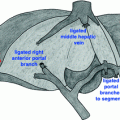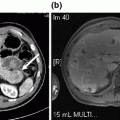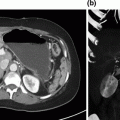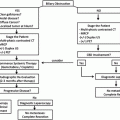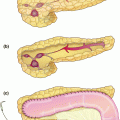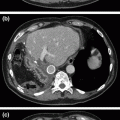Fig.s 28.1
a, b, c—a Axial and b coronal T2 weighted magnetic resonance imaging of the abdomen in a patient with multifocal BD-IPMN demonstrating innumerable pancreatic cysts. No mural nodules or solid masses are appreciated; no cyst measures >3 cm in diameter. c Coronal magnetic resonance cholangiopancreatography (MRCP) image of the same patient. The common bile duct is normal in caliber (white arrow). The main pancreatic duct is incompletely visualized; the visible portion is normal in caliber (black arrow). In this patient, EUS was subsequently performed to confirm communication between these cysts and the main pancreatic duct. EUS was also performed to fully evaluate the diameter of the main pancreatic duct throughout the entire gland
The management of patients with suspected multifocal BD-IPMN presents the clinician with a number of additional challenges in addition to those inherent in the management of solitary BD-IPMN (see box below). Among these include the ability to confidently confirm the diagnosis of multifocal BD-IPMN. Disturbingly, in one series a significant percentage of multifocal lesions preoperatively classified as BD-IPMN were found to have main pancreatic duct involvement, indicating a true diagnosis of mixed-IPMN [9]. Estimating the risk of malignancy is another challenge; even if no individual lesion displays high risk or worrisome features, is there reason to believe that multifocal disease itself is a marker of increased risk of malignancy? [21]. Fortunately, most series have not found an intrinsically higher rate of malignancy in patients with multifocal disease relative to unifocal disease (Table 28.1). In patients with intermediate-risk solitary lesions, further characterization relies heavily on EUS-FNA. This is logistically problematic in patients with innumerable lesions, all of which cannot be reasonably sampled. Finally, if surgery is to be recommended, the extent of resection is often difficult to determine on an anatomic basis. Between 17 and 52% of patients with multifocal BD-IPMN have disease that is either diffuse in nature or extends beyond the boundaries of segmental resections such as pancreaticoduodenectomy, extended pancreaticoduodenectomy, central pancreatectomy, and distal pancreatectomy [6, 22]. The surgeon therefore must often choose to perform a total pancreatectomy or choose to leave gross disease behind.
Table 28.1
Comparison of rate of invasive or malignant disease in multifocal BD-IPMN versus unifocal BD-IPMN
Author | Year | n | Rate of multifocal disease, % | Rate of malignancy a , unifocal % | Rate of malignancy a , multifocal % | Rate of invasive disease, unifocal% | Rate of invasive disease, multifocal | p– value |
|---|---|---|---|---|---|---|---|---|
Schmidt et al. [6] | 2007 | 103 | 40.7 (42/103) | n/a | n/a | 18.0 (11/61) | 7.1 (3/42) | 0.06 |
Rodriguez et al. [18] | 2007 | 145 | 25.5 (37/145) | 21.3 (23/108) | 24.3 (9/37) | n/a | n/a | ns |
Mori et al. [50] | 2012 | 211 | 19.9 (42/211) | 27.7 (15/54)b | 33.3 (5/15) b | 20.4 (11/54) | 13.3 (2/15) | ns |
Fritz et al. [51] | 2014 | 233 | 19.3 (45/233) | 25.5 (48/188) | 20.0% (9/45) | n/a | n/a | ns |
Challenges in the management of multifocal BD-IPMN
Confirmation of the diagnosis of multifocal BD-IPMN and excluding main pancreatic duct involvement.
Assessment of malignancy risk in patients with innumerable cysts.
Total pancreatectomy versus segmental resection of dominant cyst(s) with postoperative surveillance of residual disease.
Determination of surveillance method, interval, and duration in patients undergoing observation.
Clinical Management of Multifocal BD-IPMN
The management of patients with multifocal BD-IPMN ranges from complete surgical clearance of all disease via total pancreatectomy, to segmental resection of the dominant cyst with subsequent surveillance of the remnant pancreas (with or without residual disease present), to prolonged surveillance of the entire gland without surgical resection. As is the case for all patients with pancreatic cysts, surgery is recommended for those with symptomatic disease on the basis of a well-established relationship between the presence of symptoms and the risk of high-grade dysplasia and invasive disease [23].
Similarly, surgery is recommended for patients suffering from recurrent episodes of pancreatitis in association with multifocal BD-IPMN—believed to result from obstruction of the main pancreatic duct by viscous mucin. Pancreatitis is typically mild when associated with IPMN but frequently recurrent and sometimes refractory in absence of surgical intervention. The majority of the literature does not indicate an increased risk of malignancy for IPMN-associated with pancreatitis, but this is an association that has been poorly studied [24, 25]. In patients with asymptomatic disease, selection of the appropriate course of management will depend on the characteristics of the dominant cyst(s) and the location of lesions with high-risk stigmata or worrisome features. Clinicians will also have to weigh the patient’s fitness to undergo a major pancreatectomy, discuss the relative risks and benefits of surgery against the risks of prolonged surveillance, and take patient preference into account.
Total Pancreatectomy
Total pancreatectomy is the most definitive treatment for multifocal BD-IPMN, and the only curative procedure for patients with diffuse gland involvement. Total pancreatectomy has historically been avoided secondary to prohibitive perioperative morbidity and mortality, obligate pancreatic endocrine and exocrine insufficiency, and attendant poor quality of life. However, elective total pancreatectomy is being increasingly performed, and IPMN is an increasingly common indication [26–28]. A recent single-center review of 100 patients undergoing total pancreatectomy for pancreatic adenocarcinoma demonstrated a significant decrease in perioperative morbidity and mortality over the past four decades [27]. Perioperative morbidity remains common (between 19 and 66%) but is typically minor; perioperative mortality is now reported to be 2% [27, 29]. Once considered “brittle diabetes,” it has been demonstrated that postoperative glycemic control after total pancreatectomy for IPMN can be managed with similar success as in patients with type 1 diabetes mellitus. Diabetes-related quality of life is also similar between type 1 diabetics and patients post-total pancreatectomy [30, 31]. Finally, patient-reported overall quality of life after total pancreatectomy approximates or is similar to patients undergoing partial pancreatic resection [32, 33]. Nonetheless, the postoperative management of these patients remains a challenge requiring diligent management; as many as one-half of patients may require readmission within 12 months of total pancreatectomy [34].
Data regarding the outcomes of total pancreatectomy for IPMN—let alone multifocal BD-IPMN—are extremely limited. Two small cohort studies describe individual patient outcomes after total pancreatectomy for IPMN (n = 5) [35, 36]. One series of 39 patients with IPMN who underwent elective total pancreatectomy demonstrated an overall five-year survival rate of 43%; five-year survival for noninvasive and invasive disease was 90 and 22%, respectively [34]. Unfortunately, these results were not stratified based on IPMN type (main-duct versus branch-duct). For patients with noninvasive IPMN (multifocality not specified), another series demonstrated a recurrence rate of 0% (0/13) after total pancreatectomy compared to 8% (5/60) after partial pancreatectomy [37].
Which patients with multifocal BD-IPMN should be considered for total pancreatectomy? Those patients with multiple high-risk lesions meeting ICG criteria for resection who are not amenable to segmental resection on an anatomic basis may require total pancreatectomy. An argument for total pancreatectomy can also be made for those with multifocal BD-IPMN and a strong family history of pancreatic cancer. When compared to patients without a family history of pancreatic cancer, those with familial pancreatic cancer are more likely to develop an IPMN-associated malignancy in the setting of multifocal disease. These patients are also more likely to harbor high-grade dysplasia in sub-centimeter lesions [38].
Partial Pancreatectomy and Postoperative Surveillance
For the majority of patients with multifocal disease and one or more cysts that meet ICG criteria for resection, strong consideration should be given for partial pancreatectomy with postoperative surveillance. The argument for this management strategy is predicated on two facts which are supported by the literature: [1] leaving behind gross residual BD-IPMN does not increase the risk of developing subsequent malignancy in the remnant pancreas (provided no lesion with high-risk stigmata or worrisome features is missed), and [2] leaving gross residual disease does create a need for extended postoperative surveillance of the remnant pancreas, as such is required even after R0 resection of unifocal BD-IPMN. Unfortunately, supportive data is limited by the fact that the majority of series compile MD-, mixed-, and BD-IPMN together. However, it is known that the risk of recurrence and subsequent malignancy is higher after resection of MD- and mixed-IPMN compared to BD-IPMN [39]. In interpreting these studies for the purpose of managing patients with multifocal BD-IPMN, it is likely that the risk of recurrence and malignancy in the remnant pancreas is even lower than will be discussed.
Neither the presence of microscopic nor macroscopic disease in the remnant pancreas appears to increase the risk of developing IPMN-associated malignancy. In a study of 191 patients who underwent segmental resection for noninvasive IPMN (subtype not specified), 38 patients were left with disease in the remnant. One patient (1/38, 2.6%) developed invasive disease in the remnant during a mean follow-up of 41 months. Of the 153 patients with complete operative clearance of IPMN, 31 recurred in the remnant, and three developed invasive disease (3/153, 2.0%, mean follow-up 73 months). The authors therefore concluded that in comparison to those with complete operative clearance of IPMN, those with residual disease were not at increased risk for the development of malignancy [40]. Additional evidence is derived from numerous small studies demonstrating a benign course for residual BD-IPMN without high-risk stigmata or worrisome features. In a review of 37 patients with multifocal BD-IPMN, 22 patients had gross disease in the remnant that was observed with serial CT scans. Over a mean follow-up of 40 months, no clinically significant disease progression was identified [41]. Another small study demonstrated similar results, with no morphologic changes in ICG-negative BD-IPMN left in the remnant pancreas after 84 months mean follow-up (n = 16) [19]. Most recently, 33 patients with gross residual BD-IPMN after partial pancreatectomy were observed for a mean of 61 months; mean cyst size increased from 10 mm to 13 mm, and no lesion developed high-risk stigmata or worrisome features [42].
Furthermore, performing a partial pancreatectomy to remove a dominant cyst in a patient with multifocal BD-IPMN does not alter the need for postoperative surveillance. That is to say, nearly all patients undergoing partial pancreatectomy—even those with complete operative clearance of BD-IPMN—require extended surveillance. It is known that the risk of recurrence is related to the type of IPMN, presence of invasive disease, and status of the surgical margin. The largest study to date demonstrates a 17% overall recurrence rate after resection, inclusive of all subtypes of IPMN [37, 39, 42, 43]. A positive surgical margin impacts the timing and risk of recurrence, but even in the setting of negative margins the reported recurrence rate for all IPMN subtypes is 13–14% [20, 42]. One series of 210 confirmed BD-IPMNs found the overall recurrence risk to be 15%; 85% of recurrences occurred in the remnant pancreas, and 32% were invasive [42]. Thus while segmental resection is not contraindicated in patients with multifocal BD-IPMN, many authors strongly recommend postoperative surveillance of the remnant pancreas. This recommendation applies to patients in whom there is complete operative clearance of BD-IPMN as well as those with residual BD-IPMN in the remnant pancreas [19, 20, 39, 44].
The ideal duration of surveillance is unclear. Some authors have identified recurrence up to 8 years after resection, and therefore recommend indefinite surveillance[43, 44]. As our understanding of the natural history of benign-appearing BD-IPMN evolves, the recommendations for surveillance may change. One study found that in the subset of patients that underwent resection for noninvasive BD-IPMN, recurrence was almost uniformly benign (95%), prompting the authors to suggest that surveillance in that population may be unnecessary [42]. Indeed, the AGA guidelines recommend MRI surveillance of the remnant pancreas every 2 years only if the resection specimen contained high-grade dysplasia or invasive disease; the guidelines recommend against routine surveillance of the remnant when no high-grade dysplasia or invasive disease was identified in the specimen. This is justified by the low risk of malignant recurrence after resection of noninvasive BD-IPMN [15].
Stay updated, free articles. Join our Telegram channel

Full access? Get Clinical Tree


